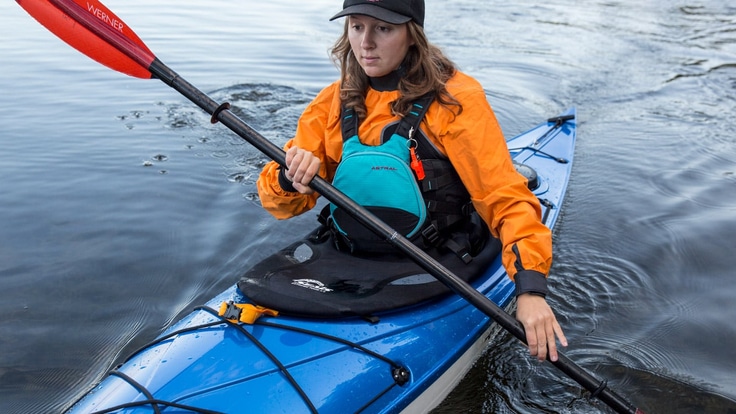Not every kayak adventure can take place in balmy weather and glassy waters. When cooler conditions prevail, you'll want a spray skirt for your sit-in kayak. Fortunately, they aren't all that complicated. Here's what you need to know when choosing a spray skirt for your kayak:
- When you need a spray skirt: Your comfort is key.
- Parts and materials: Learn the pros and cons of neoprene vs. nylon.
- A few key features: Shoulder straps and pockets can improve fit and convenience.
- How to get the right fit: You'll need to make sure the spray skirt fits both you and your boat.
When You Need a Spray Skirt
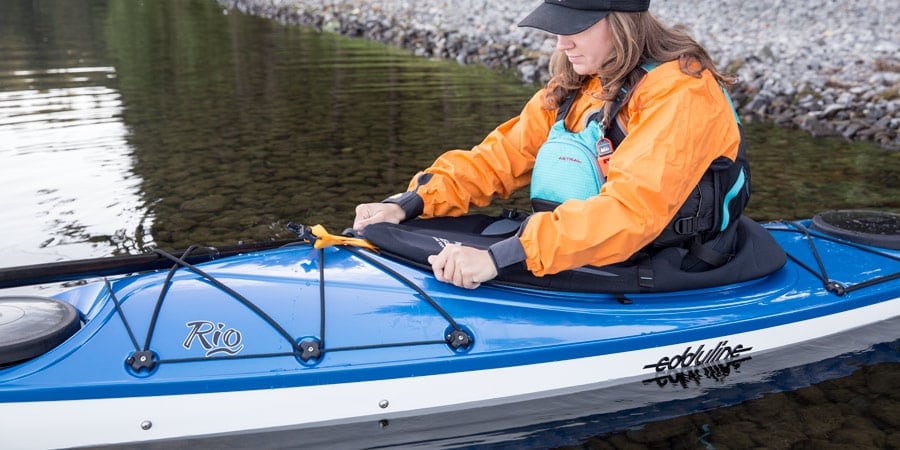
When air and water are warm, you may be more comfortable without a spray skirt because it can make things a little stuffy inside your sit-in kayak. If the water is very choppy, though, you'll want a spray skirt because waves washing over the deck could destabilize and eventually swamp your boat.
When the air and water are cold, a spray skirt helps create a warm environment inside the boat, and it keeps out rain and splashes.
Note that a spray skirt is there to increase your comfort level, not to save you from hypothermia in the event of a capsize. For more about when to wear a wetsuit or dry suit, read What to Wear Kayaking.
Spray Skirt Parts and Materials
Anatomy of a spray skirt: Spray skirts are made up of a tunnel, a deck and a rand. The tunnel is worn around the paddler's torso. The deck is the skirt portion that radiates out from the tunnel to cover the boat's cockpit. The rand, or the edge of the spray skirt, holds the deck taut by fastening over the cockpit coaming (the lip of the cockpit).
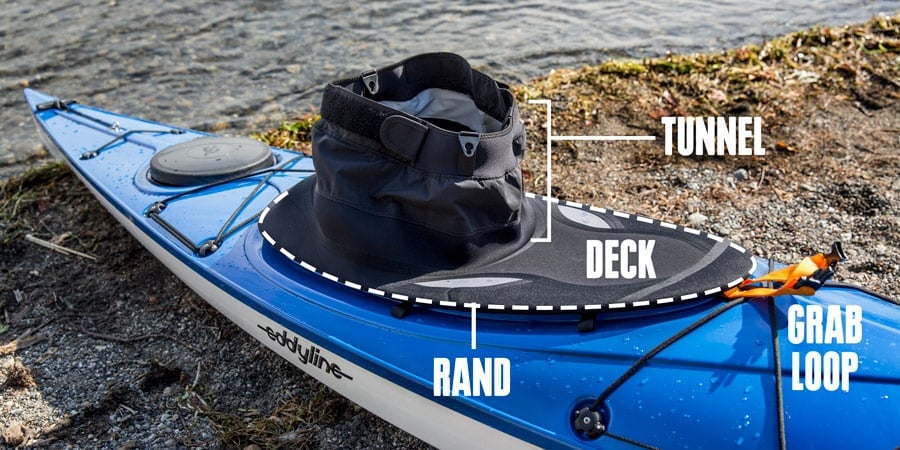
Spray Skirt Materials
Neoprene: This rugged material provides warmth when the air and water are bitterly cold. Neoprene skirts have rubber or neoprene rands that grip the cockpit coaming firmly, so the skirts can withstand the force of breaking waves or rolling a kayak. That's a plus for both whitewater and sea kayaking in extreme conditions.
Because of its tight seal, a neoprene skirt is difficult to remove during a wet exit, so it's important to practice your skirt-removal technique if you've never used a neoprene skirt before.
All-neoprene skirts have neoprene tunnels that fit snugly around your torso to seal out water there.
Nylon: All-nylon skirts will be more comfortable in moderate conditions. The nylon can be fully waterproof, waterproof/breathable or highly water resistant. The rand is often a bungee cord that provides a snug seal, but won't keep out water in a capsize.
Nylon decks are easier to attach and release than neoprene, but they don't create the tight seal needed for very rough water that neoprene decks do.
Nylon tunnels might have a spandex waistband or an adjustable fit via a drawcord or hook-and-loop fasteners. This design makes for easy venting of the cockpit but not a watertight seal at the torso. Many also have shoulder straps to hold the tunnel up.
Nylon/Neoprene: This combines the venting comfort of a nylon tunnel with the supertight seal of a neoprene deck. This design is good when conditions are variable, with the prospect of waves developing during the day.
Spray Skirt Features
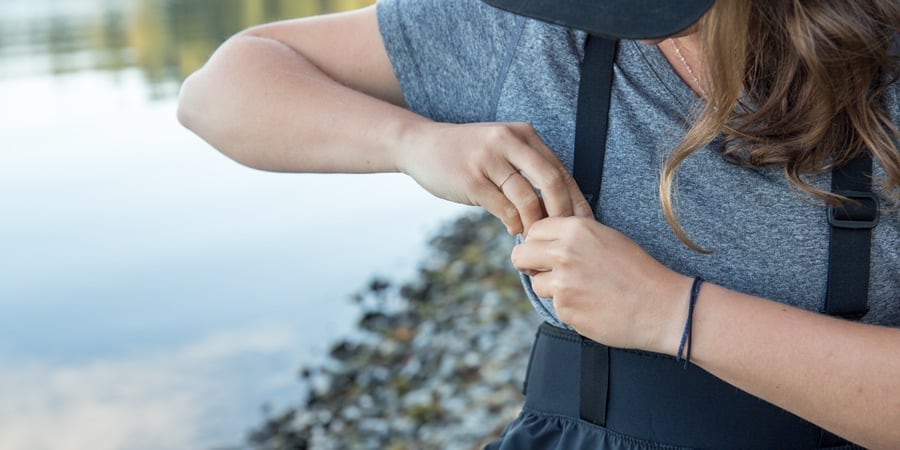
These extra features can improve performance and convenience:
- Shoulder straps: Their biggest benefit is helping to keep the tunnel fully extended to prevent water from pooling at the base of the tunnel.
- Tensioned deck stay: Helps keep a nylon deck taut and prevent water from pooling on it.
- Pockets (Interior and exterior): These are handy for stashing essentials like sunscreen, insect repellent and snacks. Pockets can be on the deck or the tunnel. Mesh pockets drain quickly, and zipper and hook-and-loop pocket closures hold things securely. Fleece-lined pockets can help you warm up cold hands.
Special Types of Spray Skirts
Splash decks: Appropriate for calm water and warm weather, this type of spray skirt attaches to the front of the cockpit to keep the paddle from dripping water onto your legs. Because it doesn't cover the whole opening, it allows air to freely circulate within the cockpit to keep you cooler.
Tandem kayak spray skirt: This fits a two-person boat that has a single open cockpit. The skirt comes in two pieces, each with its own grab loop. The pieces then fasten together in the center to create a single spray skirt that covers the overall cockpit. A tandem boat with two separate cockpits requires individual spray skirts.
How to Get the Right Fit
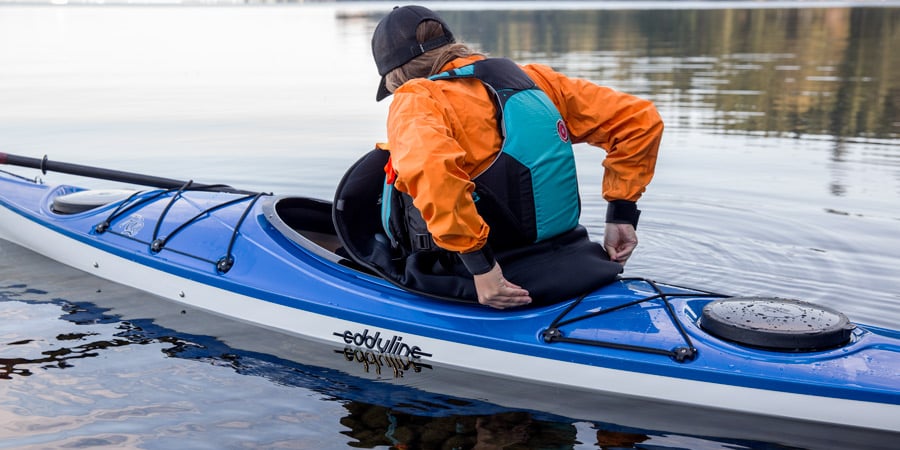
Cockpit fit: With so many cockpit sizes and shapes, a one-size-fits all skirt is not an option. Fortunately, spray skirt manufacturers have done the hard work, and have created elaborate sizing charts for you. You don't need to measure your cockpit, but you do need to know the brand and model name of your kayak.
If you can't find your model in a sizing chart, then consider a custom-made skirt. Contact spray skirt manufacturers, local paddling shops and paddling clubs to see what they recommend.
Torso fit: Nylon tunnels typically have an adjustable one-size-fits-all design. If you get a skirt with a neoprene tunnel, though, you need to measure the circumference of your "midriff" (the tunnel top sits higher than your waist, but below your chest). Then use that measurement and a skirt's tunnel sizing chart to pick your tunnel size.
Tips for putting on your spray skirt:
- To get a good fit at the waist, put on your spray skirt before you don your PFD.
- When attaching your skirt to your boat, start behind you. Slip the rand edge underneath the coaming at the rear of the cockpit. Hold it firmly there as you work your way around to the front of the cockpit, slipping the remaining rand edge under the coaming as you go.
- If your spray skirt has shoulder straps, readjust them after attaching the skirt rand to the cockpit. The goal is to ensure you have a taut deck surface.
- Always double-check that the grab loop is on the outside. In a capsize, you need to be able to instantly find and yank the loop to release the skirt.
